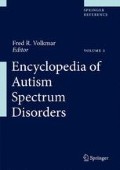Access this chapter
Tax calculation will be finalised at checkout
Purchases are for personal use only
References and Readings
Ali, Z. (2001). Pica in people with intellectual disability: A literature review of aetiology, epidemiology and complications. Journal of Intellectual and Developmental Disability, 26, 205–215.
American Psychological Association. (2000). Diagnostic and statistical manual of mentaldisorders (4th ed. Text Revision). Washington, DC: Author.
Baltrop, D. (1966). The prevalence of pica. American Journal of Diseases in Children, 112, 116–123.
Barrett, R. P. (2008). Pica: Toward understanding a complication condition. The Brown University Child and Adolescent Behavior Letter, 24(6), 5–6.
Bell, K. E., & Stein, D. M. (1992). Behavioral treatments for pica: A review of empirical studies. International Journal of Eating Disorders, 11(4), 377–389.
Bogart, L., Piersel, W., & Gross, E. (1995). The long-term treatment of life-threatening pica: A case study of a woman with profound mental retardation living in an applied setting. Journal of Developmental and Physical Disabilities, 7, 39–50.
Fisher, W., Piazza, C. C., Bowman, L. G., Hagopian, L. P., & Langon, N. A. (1994). Empirically derived consequences: A data-based method for prescribing treatment for destructive behavior. Research in Developmental Disabilities, 15, 133–149.
Hagopian, L. P., Long, E. S., & Rush, K. S. (2004). Preference assessment procedures for individuals with developmental disabilities. Behavior Modification, 28, 668–677.
Johnson, C. R., Hunt, F. M., & Siebert, M. J. (1994). Discrimination training in the treatment of pica and food scavenging. Behavior Modification, 18, 214–229.
Kern, L., Starosta, K., & Adelman, B. E. (2006). Reducing pica by teaching children to exchange inedible items for edibles. Behavior Modification, 30(2), 135–158.
Kinnell, H. G. (1985). Pica as a feature of autism. British Journal of Psychiatry, 147, 80–82.
Mace, F. C., & McKnight, D. (1986). Functional analysis and treatment of severe pica. Journal of Applied Behavior Analysis, 19, 411–416.
Matson, J. L., & Bamburg, J. W. (1999). A descriptive study of pica behavior in persons with mental retardation. Journal of Developmental and Physical Disabilities, 11, 353–361.
McAdam, D. B., Sherman, J. A., Sheldon, J. B., & Napolitano, D. H. (2004). Behavioral interventions to reduce the pica of persons with developmental disabilities. Behavior Modification, 28, 45–72.
McLoughlin, J. (1988). Pica as a cause of death in three mentally retarded persons. British Journal of Psychiatry, 152, 842–845.
Piazza, C. C., Fisher, W. W., Hanley, G. P., LeBlanc, L. A., Worsdell, A. S., Lindauer, S. E., et al. (1998). Treatment of pica through multiple analyses of its reinforcing functions. Journal of Applied Behavior Analysis, 31, 165–189.
Piazza, C. C., Roane, H. S., Keeney, K. M., Boney, B. R., & Abt, K. A. (2002). Varying response effort in the treatment of pica maintained by automatic reinforcement. Journal of Applied Behavior Analysis, 35, 233–246.
Rapp, J. T., Dozier, C. L., & Carr, J. E. (2001). Functional assessment and treatment of pica: A single case experiment. Behavioral Interventions, 16, 111–125.
Singh, N. N., Ellis, C. R., Crews, W. D., & Singh, Y. N. (1994). Does diminished dopaminergic neurotransmission increase pica? Journal of Child and Adolescent Psychopharmacology, 4, 93–99.
Stiegler, L. N. (2005). Understanding pica behavior: A review for clinical and education professionals. Focus on Autism and Other Developmental Disabilities, 20, 27–38.
Williams, D. E., Kirkpatrick-Sanchez, S., Enzinna, C., & Dunn, J. (2009). The clinical management and prevention of pica: A retrospective follow-up of 41 individuals with intellectual disabilities and pica. Journal of Applied Research in Intellectual Disabilities, 22, 210–215.
Young, S. L. (2010). Pica in pregnancy: New ideas about an old condition. Annual Review of Nutrition, 30, 403–422.
Author information
Authors and Affiliations
Corresponding author
Editor information
Editors and Affiliations
Rights and permissions
Copyright information
© 2013 Springer Science+Business Media New York
About this entry
Cite this entry
Johnson, C.R., Hassenfeldt, T.A. (2013). Pica. In: Volkmar, F.R. (eds) Encyclopedia of Autism Spectrum Disorders. Springer, New York, NY. https://doi.org/10.1007/978-1-4419-1698-3_1646
Download citation
DOI: https://doi.org/10.1007/978-1-4419-1698-3_1646
Publisher Name: Springer, New York, NY
Print ISBN: 978-1-4419-1697-6
Online ISBN: 978-1-4419-1698-3
eBook Packages: Behavioral Science

